-
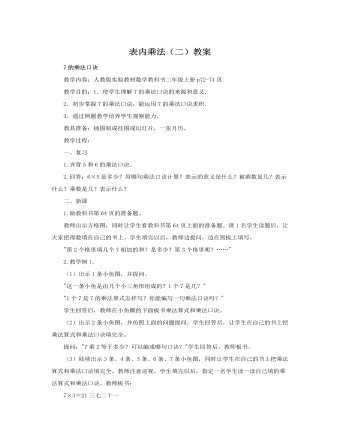
人教版新课标小学数学二年级上册表内乘法(二)教案
三、利用乘法口诀进行计算1.复习口诀的含义。任意挑出一句乘法口诀(两个因数不同的),让学生说说它表示什么意思。如"七八五十六",使学生知道它既表示8个7相加是56,又表示?个8相加是56。2.以游戏的方式开展用口诀进行计算的活动。(1)已知两个因数求积的游戏。方法是:请一位学生随意说出一个两位数,另一位学生则将这个两位数的十位数字与个位数字相乘,并算出结果,如果结果又是一个两位数,再将这个两位数的十位数字和个位数字相乘,直至结果是一位数或零。如,一位学生说:"79",另一位学生则口算:7X9=636X3=181X8=8;一位学生说:"58":另一位学生口算:5X8=404X0=0(告诉学生0和一个数相乘得零)一位学生报了3个数以后,互换角色进行。(2)已知积求两个因数的游戏。

人教版新课标小学数学六年级上册求一个数是另一个数的百分之几的应用题说课稿
第二阶段从具体步骤上的感知到解题方法的抽象概括,让学生结合板书的解题步骤,说出百分数应用题的解题方法及与分数应用题的区别与联系,通过这一阶段明确了百分数应用题的解答方法。有水到渠成之效。(三)巩固练习,促进知识内化教师出示书中的练习二十九的第1题及补充题,练习后说说理由。这一环节可以看出学生是否掌握了解答百分数应用题的方法,是否会用百分数的意义去检验结果的合理性。(四)通过出示思考题,发展提高教师在学生注意力高度集中、思维活跃的情况下引出思考题:不改变补充题的两个已知条件,你还可以提出哪些问题呢?是学习例1后知识的运用与延伸,也为今后学习求一个数比另一个数多百分之几的应用题做了铺垫。五、教学效果(一)进入六年级,进一步提高学生解答应用题的能力,并能够运用所学知识解答生活中的实际问题。
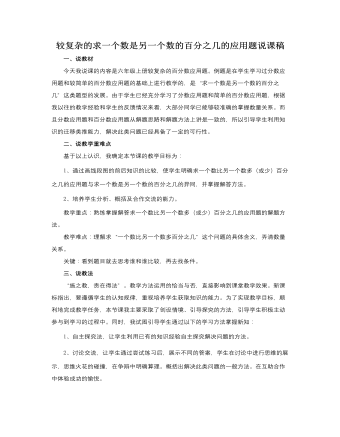
人教版新课标小学数学六年级上册较复杂的求一个数是另一个数的百分之几的应用题说课稿
1、现在每天生产的比原来多百分之几?2、原来每天生产的比现在少百分之几?3、现在每天生产的是原来的百分之几?第三层次请你为你的同桌出一道求“一个数比另一个数多(或少)百分之几”的应用题。第一组是基本练习,通过练习及两个答案的对比,让学生对单位“1”不同导致结果的不同印象深刻。第二组习题的情境设计为灾区人民急需的药品,在问题的设计上难度加大了,需要学生仔细思考,真正理解问题的含义后才能做对,锻炼了学生的思维能力。第三组请学生互相出题的目的是要检验学生对本课例题的理解程度,不仅深化了对知识的理解,而且还通过判断别人出题是否正确的同时锻炼了辨析的能力。总之,作为数学教师,本节课我力求数字简单化,让学生在情境中学习,在探究中提高,在合作中发展,体现数学活动是师生交往、共同发展的过程。
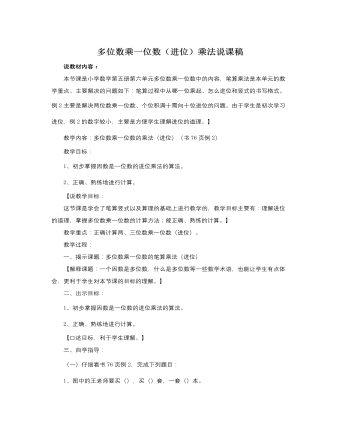
人教版新课标小学数学三年级上册多位数乘一位数(进位)乘法说课稿
说教材内容:本节课是小学数学第五册第六单元多位数乘一位数中的内容,笔算乘法是本单元的教学重点。主要解决的问题如下:笔算过程中从哪一位乘起、怎么进位和竖式的书写格式。例2主要是解决两位数乘一位数、个位积满十需向十位进位的问题。由于学生是初次学习进位,例2的数字较小,主要是方便学生理解进位的道理。】教学内容:多位数乘一位数的乘法(进位)(书76页例2)教学目标:1、初步掌握因数是一位数的进位乘法的算法。2、正确、熟练地进行计算。【说教学目标:这节课是学会了笔算竖式以及算理的基础上进行教学的,教学目标主要有:理解进位的道理,掌握多位数乘一位数的计算方法;能正确、熟练的计算。】教学重点:正确计算两、三位数乘一位数(进位)。教学过程:一、揭示课题:多位数乘一位数的笔算乘法(进位)
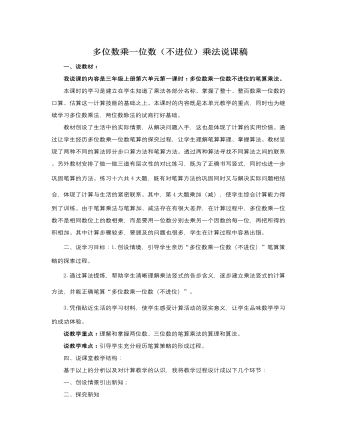
人教版新课标小学数学三年级上册多位数乘一位数(不进位)乘法说课稿
3、做练习十六第4题我用创设情境导入,接着让学生用竖式计算,并提问2是哪来的。创设情境,激发学生兴趣,使他们积极思考,主动参与,活跃课堂气氛,轻轻轻松做数学。4、判断题。让学生判断是对还是错,并说错在哪并改正。通过判断,加深学生对用竖式乘法的认识。5、做拼图题。全班合作把题完成。这道题我设计题的下面有天安门前美丽的景色。和前面文昌重建家圆相呼应。构成一个完整现实情境。通过全班合作培养学生的合作意识。四、课堂小结第四环节:总结归纳让学生说说今天学到了什么?在学生总结的同时,教师用规范的语言复述笔算乘法的计算的方法1、相同数位要对齐,2、从个位乘起,3、乘到哪一位上积就写在那一位上。使学生对所学知识有一个清晰的结构。课堂是富有生命的,说课设计毕竟不是现场上课,所以面对课堂上的生成我们还需要作出灵活的应对,我想这才是我们最大的挑战。
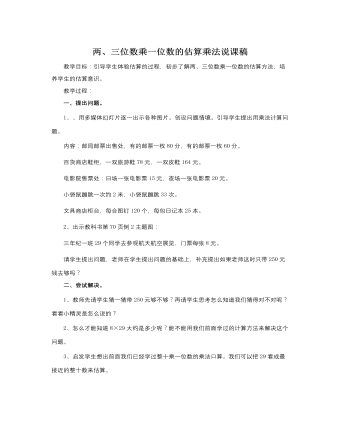
人教版新课标小学数学三年级上册两、三位数乘一位数的估算乘法说课稿
1、、用多媒体幻灯片逐一出示各种图片。创设问题情境。引导学生提出用乘法计算问题。内容:邮局邮票出售处,有的邮票一枚80分,有的邮票一枚60分。百货商店鞋柜,一双旅游鞋78元,一双皮鞋164元。电影院售票处:日场一张电影票15元,夜场一张电影票20元。小袋鼠蹦跳一次约2米,小袋鼠蹦跳33次。文具商店柜台,每合图钉120个,每包日记本25本。2、出示教科书第70页例2主题图:三年纪一班29个同学去参观航天航空展览,门票每张8元。请学生提出问题,老师在学生提出问题的基础上,补充提出如果老师这时只带250元钱去够吗?二、尝试解决。1、教师先请学生猜一猜带250元够不够?再请学生思考怎么知道我们猜得对不对呢?看看小精灵是怎么说的?2、怎么才能知道8×29大约是多少呢?能不能用我们前面学过的计算方法来解决这个问题。3、启发学生想出前面我们已经学过整十乘一位数的乘法口算。我们可以把29看成最接近的整十数来估算。
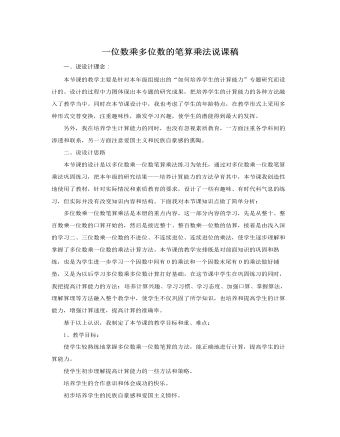
人教版新课标小学数学三年级上册一位数乘多位数的笔算乘法说课稿
三、说教法、学法从素质教育着眼点来看,要贯彻传授知识与培养能力相结合的原则,不仅要使学生学会知识,更要使学生会学、乐学、主动去学。为了更充分地发挥学生的主体地位,使他们能够自主学习,切实提高课堂教学效率。在教学方法上,采用谈话激趣、回忆交流、讨论归纳、强化练习等教学方法,循循诱导,让学生在比赛、游戏、练习、合作中自主学习,巩固和拓展所学知识。四、说教学过程“将课堂还给学生,让课堂焕发生命的活力”“努力营造学生在教学活动中自主学习的时间和空间”从这种设计理念出发,为了更好的达到教学目标,突出重点,增强教学效果,使学生计算能力得到真正发展,我对本节课设计如下几个环节:(一)、激趣导入。同学们,这几天我们一直在学习多位数乘一位数的知识,你们想不想知道我们今天要学习什么知识?
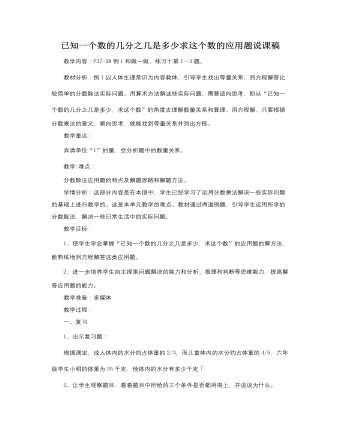
人教版新课标小学数学六年级上册已知一个数的几分之几是多少求这个数的应用题说课稿
(1)启发学生找到分率句,确定单位“1”。(2)让学生选择一种自己喜爱的解法进行计算,独立解决第二个问题。(3)指名说说自己是怎样理解题意的,并与其他同学交流自己的解题思路。(出示线段图)爸爸的体重×7/15=小明的体重方程解算术解3、巩固练习:P38“做一做”(学生先独立审题完成,然后全班再一起分析题意、评讲)三、练习1、练习十第1—3题。(先分析数量关系式,然后确定单位“1”,最后再进行解答。第二题注意引导学生发现250ml的鲜牛奶是多余条件)2、练习十第6题(引导学生先求出单位“1”——爸爸妈妈两人的工资和1500+1000,再根据数量关系式进行计算)四、总结这节课我们学习了分数应用题中“已知一个数的几分之几是多少求这个数的应用题”,我们知道了,如果分率句中的单位“1”是未知的话,可以用方程或除法进行解答。

人教版高中英语必修4Body Language说课稿4篇
Textbook: Senior English for China (Book 4), by Liu Daoyi Time Allotment: 1 period (40 minutes)Date: March 20, 2014Teaching aids: blackboard, Multi-media, Power Point, chalk I. Text Analysis (教材分析)This unit is about body language, and the text selected in the reading part demonstrates the difference and similarity of body language in many parts of the world. Through learning this passage, students are required to raise their awareness of using body language in different parts of the world. As body language is closely related to our daily life, it is easy to arouse students’ interest in learning this text. Reading skills and speaking training are designed around the text.II. Teaching Objectives (教学目标)By the end of the lesson, students will be able to:1. Language Skill Objective(语言技能目标): develop reading ability (skimming and scanning)as well as speaking ability.2. Cultural Knowledge Objective(文化知识目标): know about the cultural differences of using body language.3. Affective Objective(情感目标): increase students’ awareness of using body language correctly in different cultures. III.Teaching Focuses and Difficulties(教学重点和难点)1. Teaching Focuses(教学重点): the difference and similarity of body language in many parts of the world.2. Teaching Difficulties(教学难点): develop students’ reading abilities of skimming and scanning and ask the students to show their opinions with fluent English.

人教版高中英语必修4Women of achievement说课稿4篇
Good morning, distinguished judges:It’s my honor to talk about my teaching ideas with you. Today my topic is Women of Achievement. My presentation consists of six parts: the analysis of teaching material and student, teaching aims, key and difficult points, teaching and studying method, teaching procedures and blackboard design.First, let’s focus on the analysis of teaching material. This lesson is from New Senior English for China Student’s Book 4 Unit 1, the reading part. The main topic of the passage is the introduction of a student of Africanwildlife. After this lesson, the students will learn more information about her studying chimps in Africa, and their reading and speaking abilities can be developed as well.The next part is the analysis of students. My students are in senior high students. They have learnt English for many years, they’ve known many words and sentences, but their speaking and reading abilities are still not very good. So I will practice their speaking and reading abilities through different exercises.According to the New Standard Curriculum and the present situation, I set the teaching aims as follows: firstly, knowledge aims. Students can grasp some new words, such as worthwhile, move off. Moreover, students can understand the content of the passage and get familiar with the topic of studying chimps in wildlife. Secondly, ability aims. Students can use reading strategies such as skimming and scanning in reading process. Thirdly, emotional aims. Students can have the awareness of protecting animals and care about animals.Based on the above analysis, the key point of this lesson is to get the main idea and the detailed information from the passage; the difficult point is to talk about the wildlife protection and use reading strategies.

人教版高中英语必修3Canada-the true north说课稿4篇
Good afternoon, teachers, It’s my great pleasure to be here sharing my lesson with you.The content of my lesson is Senior English Book 3 Unit 5 Canada —— “The true North”.I’ll be ready to begin this lesson from five parts. Analysis of the teaching material,the teaching methods,the studying methods, the teaching procedure,and Blackboard design.First, let me talk about the teaching material.Part 1 Teaching Material:This unit is about the introduction of Canada. By studying of this unit,we’ll enable the students to learn the geography, population, main cities, and natural beauty, natural resources of Canada. Through the training of the unit, it also requires students to learn some Language skills such as the expressions of position and emotions.So it plays an important part in the English teaching in this book.After studying the teaching material and analyzing the rule of children’s growing of mind,I think the teaching aims are the followings:1.Knowledge objects:(1) make the students learn some new words and phrases(2) make the students understand the content of the lesson.2.Ability objects:(1)To develop the Ss’ abilities of listening, speaking, reading and writing. Especially reading and speaking ability.(2) learn to talk about the characters of Canada in English(3)To train the Ss’ ability of working in pairs.3.Emotion objects:(1)Enable students to understand the characters of Canada..(2)Stimulate Ss to work hard to make China stronger.Part 2 Teaching Methods:I think helping students learn to master new words and phrases and improve the students’ reading and speaking ability is import and the difficult.According to the analysis of the teaching material and the import points and the difficult points,I will use the following teaching methods : question-guiding approach; fast-reading and careful reading; multi-media teaching methods; discussion

人教版高中英语必修3Healthy Eating说课稿4篇
Language learning needs a context, which can help the learners to understand the language and then can product comprehensible output, so computer has the advantages to make the materials attractive.Part 3 Learning MethodsTask-based, self-dependent and cooperative learningPart 4 Teaching ProcedureStep One Lead-in“Interest is the best teacher.” Therefore, at the very beginning of the class, I should spark the students’ mind to focus on the centre topic “the band”. I’ll show some pictures of food to attract their attention and then bring some questions.Question:What kind of food they like?What should go into a good meal?The answers must relate to the diet. After this, the students will be eager to know something about a balance diet and this is the very time to naturally lead the class into Step 2Step 2 Reading for information: skimming and scanning In this step, I use Task-based Language Teaching method, which can give students a clear and specific purpose while skimming and scanning the context.Task 1 General ideaThe students will be asked to just glance at the title and the pictures of the passage, and then guess what they will read in the text. And they’ll be divided into groups of four to have a discussion.The purpose is to inspire the students to read actively, not passively. In addition, the task is to develop the students’ reading skill by making prediction and to encourage the students to express their thoughts in English and cooperate with each other.Task 2 Main idea of each paragraphCooperative learning can raise the students’ interest and create an atmosphere of achievement. Based on this theory, I divide the whole class into 4 groups to skim the whole text and get the main idea of each paragraph.

人教版高中英语必修5Great scientists说课稿4篇
通过写文章梗概,培养学生综合运用语言的能力,学习用恰当的英语描述科学家的故事。这是本课的教学难点。教师可以使用完形填空的方式来帮助学生整理语篇,从而来降低难度。本课的教学重点的突破方法是:在阅读前,让学生初步了解得出科学观点所需要的基本程序,从而轻松而自然地导入文章的阅读;在阅读过程中,由易到难设计快速阅读和精读的问题,层层推进各种阅读活动,让学生对阅读内容从整体感知到细节理解,最后深层读懂整篇文章,同时加强阅读策略的指导,让每个学生都主动参与课堂教学活动,最终达到提高阅读能力的目的。Step 4 Post-readingGroup Activities四人小组共同合作,在老师的适当指导下,就以下2个问题展开讨论,让学生就所知、所学、所感和所想融入话题,然后抽若干同学代表作小组发言。1. What do you think about John Snow, and what should we learn from him?2. Cholera was 19th century disease, which two diseases are similar to cholera today? Why?

人教版高中英语必修5Making the news说课稿4篇
今天我们来介绍一下必修五第四单元的授课方式。这个单元的题目是Making the news。应该是学生比较感兴趣的话题,学生往往对新闻工作充满好奇,所以我们可以利用这个机会多设计一些师生互动和学生互动,来激发起学习的积极性,提高学习效率。同时我们可以利用这个单元不仅帮助学生掌握语言知识,培养语言能力,同时让其了解新闻工作的重要性,培养起社会智能感。这个单元分为六个课时,它的教学目标是这样的:语言目标是掌握词汇表中的常用单词和短语,掌握倒装句的一些基本用法。 技能目标是能初步掌握约会的基本句型并在真实的场景下正确运用。新闻报道类文章的写作技能。采访的基本规范和沟通技能。情感目标是对新闻报道的客观性和真实性有更好的理解。对新闻记者的职业有更深入的了解,并能体会其工作的重要性。下面我们来介绍一下第一课时的授课方式,第一课的教学目标是这样的第一课时的教学目标语言目标:单词:Occupation, journalist, editor, photographer, curious, personality, enthusiasm

人教版高中英语必修5The United Kingdom说课稿4篇
Teaching Aims:Knowledge 1. Get the students to learn the useful new words and expressions in this section. Aims:2. Let the students learn about how the UK was formed and the four groups of invaders.1. Develop students’ reading ability and let them learn different Ability reading skills. Aims:2. Enable students to learn to talk about the United Kingdom and the Union Jack Emotional 1. Let students know more about the UK2. Develop students’ sense of cooperative learning Aims:Teaching Important Points:1. Let the students learn about the countries of the United Kingdom and the Union Jack2. Get the students to read the passage and know about how the UK was formed and the four groups of invaders.3. Have the students learn different reading skills.Teaching Difficult Ponts:1. Develop students’ reading ability.2. Enable students to talk about the United Kingdom and the Union Jack.3. Let students learn how the UK was formed geographically and historically.Teaching Methods:Showing pictures, asking, exercising, listening, reading etc.Teaching Aids:A computer,a projector and a blackboard.Teaching Procedures: 1) Show a map of the world, ask students the following questions:Where is the UK?What’s the full name of the UK?2) Ask the students work in pairs to do the quiz on Page 9.Do you want to test how many things you know about the United Kingdom? Let’s have a small test.Using the map on P9, students answer the following questions:?How many countries does the UK consist of? What are they??England is divided into three main areas. Do you know what they are? 1) Scanning (10Minutes )Let the students hold the questions asked in pre-reading and read the passagequickly and then let them do the following exercise.Join lines to the right answer.
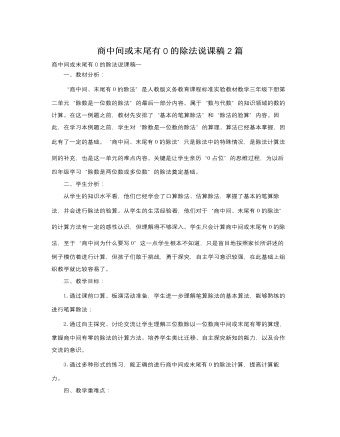
人教版新课标小学数学三年级下册商中间或末尾有0的除法说课稿2篇
教法、学法分析我通过阅读教材、教参和新课标,分析学生学习状况,认为对这一教学内容理解起来比较容易。所以,在教学时我准备采取以下策略:1、放手让学生自主解决问题,尝试计算例7的1、2题。再通过学生口述计算过程,教师设问、强调重点使学生掌握本节课知识。2、通过学生反复叙述算理,培养学生口头表达能力,并使他们自主探索“被除数中间或末尾没有0,商中间或末尾有0”这一知识形成的过程。教学目标1、在熟练掌握一位数笔算除法法则的基础上,会正确计算商中间或末尾有0的除法的另一种情况。2、能熟练地进行商中间有零和末尾有零的除法,形成一定的笔算技能。3、能结合具体情境估算三位数除以一位数的商,增强估算的意识和能力。

部编人教版一年级下册《静夜思》说课稿
一、 说教材《静夜思》是一年级下册第四单元第7课的一篇李白的古诗,他的诗想象丰富,风格飘逸豪放。《静夜思》写的是游子月夜思乡之情。作者以一个游子的身份神驰万里,从“疑”到“举头”,从“举头”到“低头”,形象地表现了诗人的心理活动过程,一幅鲜明的月夜思乡图生动地呈现在我们面前,表达了游子强烈的思乡情感。这首诗语言凝练,感情真挚,意境深远,容易引起读者的共鸣。二、 说学情这首诗通俗易懂,家喻户晓,有的学生在入学之前已经倒背如流。但是多数学生在朗读古诗的韵味上缺乏锻炼。所以教学本诗,应重在吟诵,指导学生读准字音,读出节奏,激发学习古诗的兴趣,引导学生在读中感悟诗中绵绵的思乡之情,体会诗歌的韵味和美好的意境。
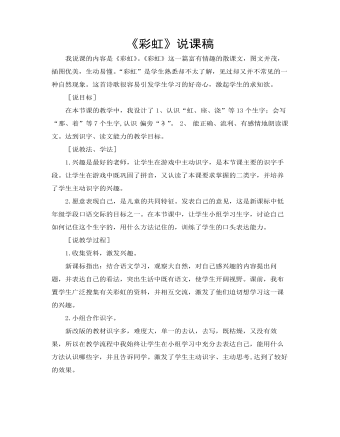
部编人教版一年级下册《彩虹》说课稿
我说课的内容是《彩虹》。《彩虹》这一篇富有情趣的散课文,图文并茂,插图优美,生动易懂。“彩虹”是学生熟悉却不太了解,见过却又并不常见的一种自然现象。这首诗歌很容易引发学生学习的好奇心,激起学生的求知欲。[说目标]在本节课的教学中,我设计了1、认识“虹、座、浇”等13个生字;会写“那、着”等7个生字,认识 偏旁“衤”。 2、 能正确、流利、有感情地朗读课文。达到识字、读文能力的教学目标。
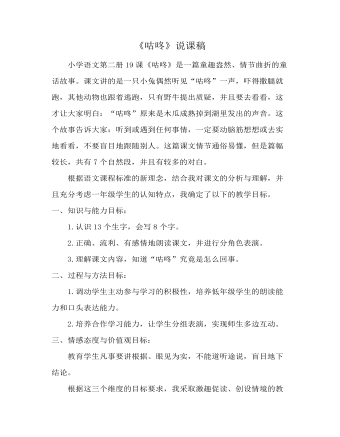
部编人教版一年级下册《咕咚》说课稿
一、创设情境,设置悬念,激趣导入。好的开端是一堂课成功的一半。正因为如此,我运用激趣导入,进行猜谜语、听声音比赛。利用课件引导学生的听觉、视觉、思维想象多渠道运作起来,积极参与到学习中。而且我还特别设计了个别声音用耳朵比较难以辨别,学生只好用眼睛揭开谜底,从而初步接触课文“眼见为实”的主旨。最后出示“咕咚”的声音,让学生猜猜这样的声音通常在什么情况下会出现,激发他们的想象力。让学生模拟发“咕咚”声,从而引出课题。并且告诉大家:千万别小看这个有点奇怪的声音,它可在森林中掀起了一场不大不小的风波呢。

部编人教版一年级下册《夜色》说课稿
一、说教材:《夜色》是一首儿歌,采用第一人称,写“我”从前胆子很小很小,很怕黑。后来“我”和爸爸出去散步,发现夜晚也像白天一样美好,从此不再怕黑了。儿歌分两个自然小节。整篇语言生动活泼,通俗易懂,充满童趣。怕黑的天性却使孩子们看不到夜的美丽,阻挡了孩子们探索的视野。夜晚的星空是怎样璀璨?夜晚的花草是怎样的微笑?夜晚的大地又是怎样唱着无声的歌?柯岩的《夜色》正是捕捉到孩子们怕黑的心理,以打动儿童心扉的文字,呼唤着孩子们亲近自然,热爱生活。课文分两小节。第一小节写到:我从前胆子很小很小,天一黑就不敢往外瞧。妈妈讲了许多勇敢的故事,可我一看窗外,心儿还是乱跳。这一节以第一人称的叙述语言开头,讲述了“我”是多么怕黑,孩子们很容易产生共鸣。